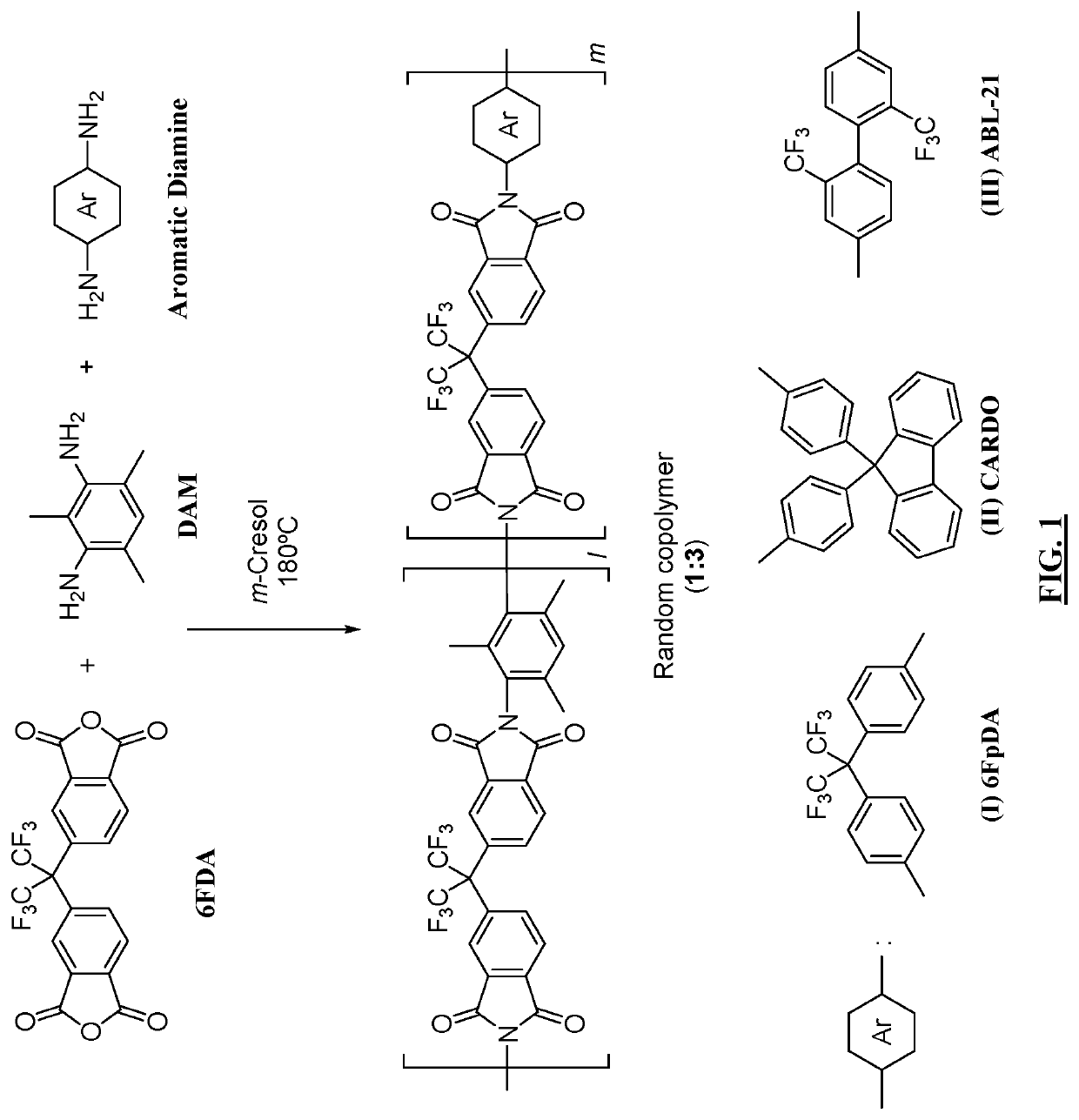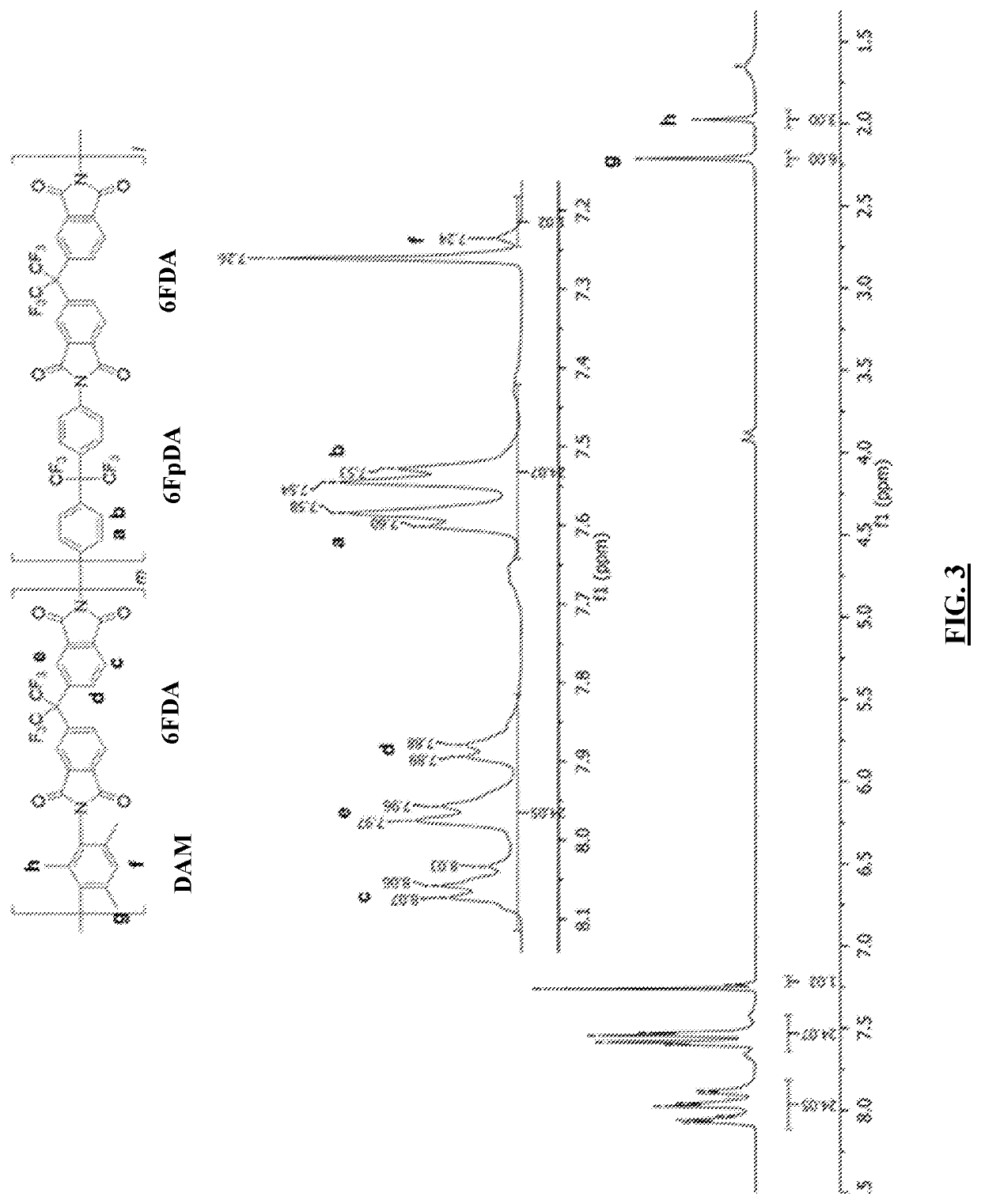Aromatic co-polyimide gas separation membranes derived from 6fda-dam-type homo-polyimides
a technology of copolyimide and homo-polyimide, which is applied in the separation process, gaseous fuels, petroleum industry, etc., can solve the problems of toxic hsub>2/sub>s, harmful combustion, and acid gas can corrode transportation pipelines, etc., and achieves flexible operation, less footprint, and more energy efficiency.
- Summary
- Abstract
- Description
- Claims
- Application Information
AI Technical Summary
Benefits of technology
Problems solved by technology
Method used
Image
Examples
example 1
on of Aromatic Random Co Polyimide 6FDA-DAM / 6FpDA (1:3)
[0068]Random aromatic 6FDA-DAM / 6FpDA (1:3) co-polyimide (FIG. 3) was synthesized according to the following procedure from 2,2′-bis-(3,4-dicarboxyphenyl) hexafluoropropane dianhydride (6FDA) (obtained from Alfa Aesar), 2,4,6-trimethyl-m-phenylenediamine (DAM) (obtained from TCI America), and 4,4′-(hexafluoroisopropylidene)dianiline (6FpDA) (obtained from TCI America). The solvents used include Methanol (obtained from ThermoFisher Scientific) and m-cresol (obtained from Alfa Aesar). All the chemicals and solvents used in this work were used as received without any further purification.
[0069]Synthesis of random co-polyimide 6FDA-DAM / 6FpDA (1:3) (I): In a 100-mL three-neck round bottom flask equipped with a nitrogen inlet and a mechanical stirrer DAM (0.300 g, 1.994 mmol), 6FpDA (2.00 g, 5.98 mmol), and 6FDA (3.54 g, 7.98 mmol) were mixed in m-cresol (16.00 ml). The mixture was heated at 180° C. for 8 hours. The solution was dilute...
example 2
on of Aromatic Random Co Polyimide 6FDA-DAM / CARDO (1:3)
[0071]Random aromatic 6FDA-DAM / CARDO (1:3) co-polyimide was synthesized according to the following procedure from 6FDA (obtained from Alfa Aesar), DAM (obtained from TCI America) and CARDO (obtained from TCI America). The solvents used included methanol (obtained from ThermoFisher Scientific) and m-cresol (obtained from Alfa Aesar). All the chemicals and the solvents used in this work were used as received without any further purification.
[0072]Synthesis of random co-polyimide 6FDA-DAM / CARDO (1:3) (II): A similar procedure for preparing co-polyimide (I) was employed using the following amounts of starting materials: DAM (0.287 g, 1.913 mmol), CARDO (2.00 g, 5.74 mmol), and 6FDA (3.40 g, 7.65 mmol) in m-cresol (15.00 ml). The final product 6FDA-DAM / CARDO (1:3) (II) (4.65 g, 3.46 mmol, 90% yield) was obtained as a white off solid material. Characterization resulted in the following: 1H NMR (500 MHz, CDCl3) δH 8.05-7.81 (m, 24H, Ar...
example 3
on of Aromatic Random Co Polyimide 6FDA-DAM / ABL-21 (1:3)
[0073]Random aromatic 6FDA-DAM / ABL-21 co-polyimide was synthesized according to the following procedure from 6FDA (obtained from Alfa Aesar), DAM (obtained from TCI America) and ABL-21 (obtained from TCI America). The solvents used included methanol (obtained from ThermoFisher Scientific) and m-cresol (obtained from Alfa Aesar). The chemicals and the solvents used in this work were used as received without any further purification.
[0074]Synthesis of random co-polyimide 6FDA-DAM / ABL-21 (1:3) (III): A similar procedure for preparing co-polyimide (I) was employed using the following amounts of starting materials: DAM (0.383 g, 2.55 mmol), ABL-21 (2.45 g, 7.65 mmol), and 6FDA (4.53 g, 10.20 mmol) in m-cresol (20.00 ml). The final product 6FDA-DAM / ABL-21 (1:3) (III) (6.38 g, 4.84 mmol, 95% yield) was obtained as a white solid product. Characterization of the product resulted in the following: 1H NMR (500 MHz, CDCl3) δH 8.14-7.87 (m,...
PUM
| Property | Measurement | Unit |
|---|---|---|
| feed pressure | aaaaa | aaaaa |
| Tg | aaaaa | aaaaa |
| pressures | aaaaa | aaaaa |
Abstract
Description
Claims
Application Information
 Login to View More
Login to View More - R&D
- Intellectual Property
- Life Sciences
- Materials
- Tech Scout
- Unparalleled Data Quality
- Higher Quality Content
- 60% Fewer Hallucinations
Browse by: Latest US Patents, China's latest patents, Technical Efficacy Thesaurus, Application Domain, Technology Topic, Popular Technical Reports.
© 2025 PatSnap. All rights reserved.Legal|Privacy policy|Modern Slavery Act Transparency Statement|Sitemap|About US| Contact US: help@patsnap.com



